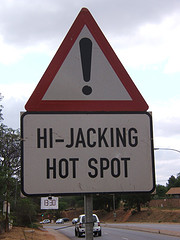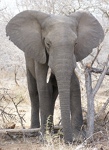- Travel + Photos
- Voyages
- South Africa
South Africa

In a Nutshell
The San inhabited South Africa some 25000 years BC. AD 100-500, Bantu-speakers arrived in present-day KwaZulu-Natal. The first Europeans (Portuguese, lead by Bartholomeu Dias) reached South Africa in 1487. The first Dutch arrived in 1647 and a permanent Dutch settlement was established in 1652 by the Dutch East India Company. Great Britain took over in 1795 to prevent the French from taking the Cape Colony, returned it to the Dutch in 1803, then annexed it in 1806. The Act of Union was signed in 1910, created the Union of South Africa from the Cape and Natal colonies, and the republics of Transvaal and Orange Free State. The Union was still a British territory with home-rule for Afrikaners. In 1948, the National Party gained control of the government and apartheid was institutionalised. In 1961, the country left the Commonwealth and became the Republic of South Africa, independent of British sovereignty. Apartheid was dismantled in a series of negotiations from 1990 to 1993, culminating in South Africa's first universal suffrage in 1994. South Africa then rejoined the Commonwealth Nations.
Burghers are the Dutch that were released from their contract with the Dutch East India Company (VOC) and permitted to establish their own farms, from which they would supply the VOC settlement with their harvests. Boer, short for Trekboers (wandering farmers) are burghers that became nomad, once moved into the rugged hinterlands of the north and east. Voortrekkers (pioneers) are the Boers who grew dissatisfied with the British rule in the Cape Colony and started to trek off into the interior in search of land and freedom in the 1830s and 1840s.
Population: 49 991 300. Ethnic groups: 79.4% Black, 9.2% White, 8.8% Coloured, 2.6% Asian. (2010 estimate)
South Africa recognizes 11 official languages (Afrikaans, English, Ndebele, Northern Sotho, Sotho, Swazi, Tswana, Tsonga, Venda, Xhosa and Zulu) and several unofficial languages. According to the 2001 National Census, the three most spoken first home languages are Zulu (23.8%), Xhosa (17.6%) and Afrikaans (13.3%); English is spoken by only 8.2% of South Africans at home.
South African wine dates back to 1659, making it the oldest wine industry anywhere outside of Europe. Pinotage (a mix of Pinot Noir and Hermitage) is a red wine grape that is South Africa's signature variety.
The Experience

It's hard for me to describe South Africa. It's not a third world country even though there are a lot of extremely poor people (evidenced by the ever sprawling townships). It's not a developed country despite the fact that it's part of the G20 and its infrastructure can rival with any western countries. You could be driving on a nicely paved highway at 130 km/h and see people carrying loads on their head, walking on the side of the highway just like they would on a dirt path in a village. You can see a lot of nice cars (Porche, BMW, Audi etc.) on the roads, but you also see a lot of people use their two feet or their thumb along the roads as a mean of transportation. The government encourages recycling, but in some places or villages, you see trashes spread out like in a third world country.
Crime is a problem, and according to some locals, it is getting worse. Road signs such as Hi-jacking hot spot
and High crime zone. Do not stop
don't reassure either. Shopping malls seem to be the safest places as they are gated and have armed guards patrolling inside. Insecurity probably contributes to the weirdness I felt because in certain towns/areas, you're not supposed to walk around at night, so that once the sun set, I can't do what I'm used to doing on my trips: exploring the town. That said, the only time I didn't feel safe was when by accident we drove too close into Mdantsane, a sprawling township outside of East London. You don't need to be paranoid, just be armed with common sense to avoid troubles.
The high unemployment rate in South Africa (~24% in 2010) probably contributes to crime. When you have a big family to feed and no job, you have to do something. One time, a guy came up to me while I was loading the car and said he was hungry. Long story short, I asked what he wanted and he said 10 or 20 cents (0.20 Rand = 0.028 USD = 0.021 EUR). To put it in perspective, a 2L bottle of Coca-Cola costs ~13 Rand, so the guy must be very poor to ask for only 0.20 Rand. That was the only time someone begs me for money in South Africa (unlike some other countries where people nag you for money all the time). At the gas station, workers ask to clean your windshield, for which it is customary to give 1-2 Rand. People also stand on the street and watch the parked cars. When you leave, they ask for some money. At first, I thought it was a scam to extort money from tourists. It turned out that they do actually watch after your car (for break-in or theft), whether you're a tourist or local. It is customary to give 1-2 Rand for such service
.
Overall, I didn't find the people aggressive (but of course, I didn't get mugged). On the contrary, they are very friendly. The Black people don't come and talk to you easily, but once you engage them in a conversation, they always have that friendly smile and easy laugh. Talk to the locals and you can avoid a lot of troubles.
The driving in South Africa is a mix of developed and developing countries. People respect traffic lights (called robots in South Africa) and stay in their lane. But they also pass in no overtaking zones, mostly thanks to the slower cars moving to the shoulder of the road to make room for faster cars to pass, even when there are cars coming the opposite direction or in blind curves. In such case, people blink their hazard light twice to thank (for letting me overtake you, buddy), which is replied by one or two headlight flashes (no problemo amigo). Things to watch out for on the road are the people walking on the side of the road and minibus taxis that are notorious for causing a lot of deadly accidents.
The police sets random speed traps on foot on the roads. One officer checks the cars' speed with a laser radar, the others stop the offending cars by stepping out on the road/highway, pointing at them and wave them over. Just like in Europe, cars going in opposite direction flash their headlight at you to warn about the cops. So one day, I drove past a speed trap and flashed the on coming cars to warn them. But it turned out that one of the on coming cars was a police car. Oops!
Practical Details

Dates of the trip: 13-Oct to 1-Nov 2010
Kruger National Park is one of the largest game reserves in Africa. It covers various animal habitats over 18 989 km2 (7 332 sq mi) and extends 360 km (220 mi) from north to south and 65 km (40 mi) from east to west. It's better to stay several days inside Kruger NP, in different camps at different areas in order to see more animals. My cousin and I stayed at Skukuza and could only cover a 50 km radius during our 3 full-day stay. Animals (predators) are most active early in the morning and late afternoon/early evening, you can thus maximize your chances of seeing them at these times.
At Royal Natal Naitonal Park, you can drive to the top of Mont-aux-Sources. But it is a long drive from the NP (2-3 hours one way) as you have to get back out to Bergville and toward Harrismith. I was told the view of the Amphitheatre from up there is even more impressive than from within Royal Natal NP.
If you intend to visit a lot of national parks or have a long stay in a park whose conservation fees are high (such as Kruger), it may be worth investing in a Wild Card.
Visit to Robben Island in Cape Town is very popular. If you absolutely have to visit it on a given day, make sure to book the ticket in advance; it could be sold out for a given day.
The floor of the Table Mountain cableway cars rotates through 360º, giving passengers the full panoramic view. So as long as you're not in the middle of the car, you'll see everything.
Food and wine are excellent in the wine countries and Cape Town. Steak is good throughout South Africa. In particular at Guineafowl Restaurant in Ladysmith where the filet is excellent and cheap. The most surprising restaurant was Die Strandloper Seafood Restaurant in Langebaan, which Nikki from Buller's Rest Lodge in Ladysmith told me about. It serves a 10-course seafood meal in a relax atmosphere on the beach. It doesn't accept credit card, so come with cash.
Links
- http://www.sanparks.org
- The official site of South Africa National Parks
- http://www.southafrica-travel.net/Parks/e_parks.htm
- A guide to Nature Reserves and Game Parks in South Africa
- http://www.southafricalogue.com/travel-tips/crime-in-south-africa-know-the-score.html
- A perspective on crime in South Africa
- Café Dijon
- An excellent French restaurant in Stellenbosch. They only play French music to make the ambiance.
- Die Strandloper Seafood Restaurant
- A seafood restaurant on the beach in Langebaan, 125 km north of Cape Town, that serves a 10-course meal.
Copyright © 2010, Northwest Summit. All rights reserved.
No part of this page may be reproduced, republished or copied without the express written permission of its author.



